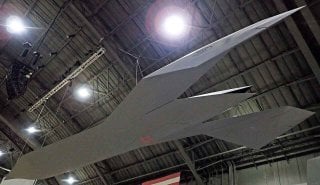Will Russia's "PAK DA" Stealth Bomber Ever See the Light of Day?
While limited information surrounding Russia’s new project is available, the upcoming stealth bomber will allegedly be equipped with conventional, nuclear and hypersonic weapons.
As geopolitical tensions across the globe continue to escalate, the race to produce sixth-generation technology is on. The U.S., Russia and China are working to develop their respective next-gen bombers and fighters alike. Washington’s Next-Generation Air Dominance (NGAD) and B-21 Raider, Moscow’s PAK DA and Beijing’s Xi’an H-20 represent just some of these futuristic proposals. Due to its ongoing Ukraine invasion, Russia may be less equipped financially and resource-wise to introduce its stealth bomber as planned. The PAK-DA, designed to rival the American-made B-2 Spirit and the upcoming Raider, would guarantee Moscow aerial clout in the skies if produced before its competitors. While limited information surrounding Russia’s new project is available, the upcoming stealth bomber will allegedly be equipped with conventional, nuclear and hypersonic weapons.
Introducing Russia’s sixth-gen stealth bomber
Described as Moscow’s sixth-generation bomber, PAK DA will incorporate a range of advanced attributes when introduced. From stealth and internal weapon bays to supersonic flight capabilities, PAK DA is set to rival its cutting-edge near peers. In fact, many of the qualities being woven into the sixth-generation design mimic the U.S.-made B-2 Spirit. Like the older American platform, PAK DA has a “flying wing” shape. Unlike typical aircraft design, the Spirit (and PAK DA) do not possess the typical parts of an aircraft, a fuselage, wings, and an empennage or tail assembly with flight control surfaces. Instead, the platform relies on an advanced flight control computer to retain stability in the air. Additionally, the Russian bomber will also fly at subsonic speeds and feature a low radar cross-section.
While Russia’s previous attempts at producing “stealth” have not been overly fruitful in the past, the PAK-DA certainly has the stealth look with its sleek flying wing design. Despite the bomber’s potential, it is unlikely that Moscow will be able to produce PAK-Das any time soon. Russia has been embroiled in its Ukraine invasion for nearly three years, quickly running through its financial and material supplies in the process. Since the Kremlin’s priorities are currently centered on achieving their war objectives in Ukraine, the development of future technologies appears to have taken a back seat.
How does PAK-DA compare to its counterparts?
China and the U.S. are also striving to introduce their own stealth bombers in the upcoming years. Developed by Northrop Grumman, the Raider will serve multiple roles for the Air Force once in commission, including as an intelligence collector and as a stealthy battle manager. Limited information surrounding the specs and capabilities of the B-21 have been made public, however, the platform will undoubtedly feature the latest and greatest technologies as it will represent the aerial component of America’s nuclear triad. China’s H-20 bomber is expected to function similarly and is certainly being designed to achieve full air superiority. Notably, Western analysts believe the H-20 could have a range of 8,500 kilometers, which is concerning since a bomber with this range could reach beyond the First Island Chain off the coast of China and into the Philippines, Japan, or even the U.S. territory of Guam.
Since tensions between Beijing, Washington and Moscow are only mounting, a sobering look at each nation’s stealth bomber progress is essential.
Maya Carlin is a National Interest security contributor, an analyst with the Center for Security Policy, and a former Anna Sobol Levy Fellow at IDC Herzliya in Israel. She has by-lines in many publications, including The National Interest, Jerusalem Post, and Times of Israel.
Image: Wikimedia Commons.

